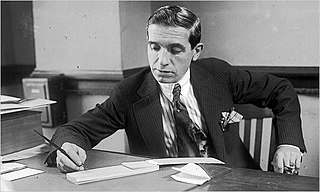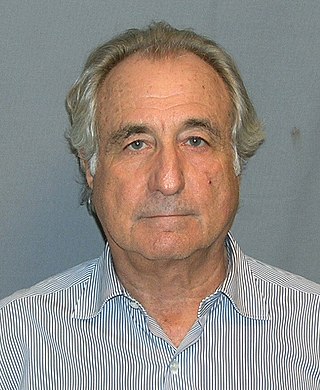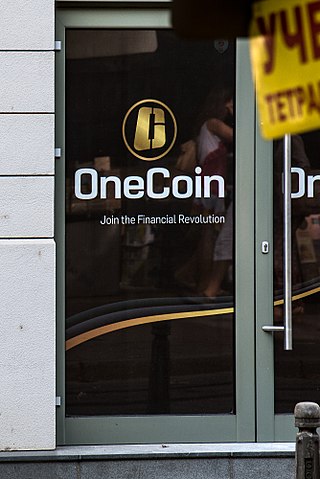Related Research Articles

Charles Ponzi was an Italian swindler and con artist who operated in the U.S. and Canada. His aliases included Charles Ponci, Carlo, and Charles P. Bianchi.

A Ponzi scheme is a form of fraud that lures investors and pays profits to earlier investors with funds from more recent investors. Named after Italian businessman Charles Ponzi, this type of scheme misleads investors by either falsely suggesting that profits are derived from legitimate business activities, or by exaggerating the extent and profitability of the legitimate business activities, leveraging new investments to fabricate or supplement these profits. A Ponzi scheme can maintain the illusion of a sustainable business as long as investors continue to contribute new funds, and as long as most of the investors do not demand full repayment or lose faith in the non-existent assets they are purported to own.

A pyramid scheme is a business model which earns primarily by enrolling others into the scheme, however rather than earning income by sale of legitimate products to an end consumer, it mainly earns by recruiting new members with the promise of payments. As recruiting multiplies, the process quickly becomes increasingly difficult until it is impossible, and most members are unable to profit; as such, pyramid schemes are unsustainable and often illegal.
A high-yield investment program (HYIP) is a type of Ponzi scheme, an investment scam that promises unsustainably high return on investment by paying previous investors with the money invested by new investors.
The Foundation for New Era Philanthropy was a Ponzi scheme that operated from 1989 until its collapse in 1995 after having raised over $500 million from 1100 donors and embezzling $135 million of this. Most of the money was stolen from Christian religious organizations and charities in the Philadelphia, Pennsylvania area. The scheme was publicly discovered by Albert Meyer, an accounting teacher at Spring Arbor College and the auditing firm Coopers & Lybrand working with its client, a local religious college in Los Angeles who suffered no loss in its participation.
Sibtul Hasan Shah, alias Double Shah, was a scam artist in Pakistan, who gained notoriety by starting and managing a Ponzi scheme.

Bernard Lawrence Madoff was an American financial criminal and financier who was the admitted mastermind of the largest known Ponzi scheme in history, worth an estimated $65 billion. He was at one time chairman of the Nasdaq stock exchange. Madoff's firm had two basic units: a stock brokerage and an asset management business; the Ponzi scheme was centered in the asset management business.

The Madoff investment scandal was a major case of stock and securities fraud discovered in late 2008. In December of that year, Bernie Madoff, the former Nasdaq chairman and founder of the Wall Street firm Bernard L. Madoff Investment Securities LLC, admitted that the wealth management arm of his business was an elaborate multi-billion-dollar Ponzi scheme.

Steven Jude Hoffenberg was an American businessman and fraudster. He was the founder, CEO, president, and chairman of Towers Financial Corporation, a debt collection agency, which was later discovered to be a Ponzi scheme. In 1993, he rescued the New York Post from bankruptcy, and briefly owned the paper. Towers Financial collapsed in 1993, and in 1995 Hoffenberg pleaded guilty to bilking investors out of $475 million. He was sentenced to 20 years in prison, plus a $1 million fine and $463 million in restitution. The U.S. SEC considered his financial crimes to be "one of the largest Ponzi schemes in history".

Participants in the Madoff investment scandal included employees of Bernard Madoff's investment firm with specific knowledge of the Ponzi scheme, a three-person accounting firm that assembled his reports, and a network of feeder funds that invested their clients' money with Madoff while collecting significant fees. Madoff avoided most direct financial scrutiny by accepting investments only through these feeder funds, while obtaining false auditing statements for his firm. The liquidation trustee of Madoff's firm has implicated managers of the feeder funds for ignoring signs of Madoff's deception.
International Investment Group (IIG) is an American financial institution that specializes in short-term trade finance and commercial finance with a focus on emerging markets. Through its affiliate IIG Capital it provides financing to small and medium-sized merchants, traders and processors with a need for supply chain financing.

The Saradha Group financial scandal was a major political scandal caused by the collapse of a Ponzi scheme run by Saradha Group, a consortium of over 200 private companies that was believed to be running collective investment schemes popularly but incorrectly referred to as chit funds in Eastern India.
The Mantria Corporation Ponzi scheme has been described as the "biggest green energy scam" in United States history. A Federal judge in the Securities and Exchange Commission's civil case found Mantria had scammed more than $54.5 million “by egregiously, recklessly, knowingly, and shamelessly perpetrating a fraudulent scheme” that used “misrepresentations, omissions, and blatant lies to induce unsuspecting and unwitting victim investors to liquidate the equity in their homes and take out bank loans to invest in Defendants’ scheme, which was nothing more than smoke and mirrors.” On November 16, 2009, the U.S. Securities and Exchange Commission charged four people who targeted those nearing retirement age who were seeking real estate and "green" investments. Many of these securities were offered by Mantria Corporation.
MMM Global is a Ponzi scheme launched in 2011 by Sergei Mavrodi, with subsidiaries in up to 110 countries. MMM Global is a new avatar of the Russian company MMM, also created by Mavrodi and which operated from 1989 to 2004. The difference between the two is that MMM Global targets developing countries. MMM Global became widely popular in various African countries such as South Africa, Nigeria, Zimbabwe, Kenya and Ghana, with some attributing this popularity to poverty and poor government regulation or law enforcement.

Quadriga Fintech Solutions was the owner and operator of QuadrigaCX, which was believed to be Canada's largest cryptocurrency exchange at the time of its collapse in 2019, with the exchange ceasing operations and the company filing for bankruptcy with C$215.7 million in liabilities and about C$28 million in assets.

OneCoin is a fraudulent cryptocurrency scheme conducted by offshore companies OneCoin Ltd, based in Bulgaria and registered in Dubai, and OneLife Network Ltd, both founded by Ruja Ignatova in concert with Sebastian Greenwood. OneCoin is considered a Ponzi scheme due to its organisational structure of paying early investors using money obtained from newer ones. It was also a pyramid scheme due to the recruiting of investors without providing any actual product. The company secretly conducted database entry scam simulating transactions not registered by an actual blockchain, and with no mining behind the apparent cryptocurrency release and circulation. Many of those characters central to OneCoin had been previously involved in similar and different other schemes and business malpractices separate from each other. OneCoin was described by The Times as "one of the biggest scams in history".

Bitconnect was an open-source cryptocurrency in 2016–2018 that was connected with a high-yield investment program, a type of Ponzi scheme. After the platform administrators closed the earning platform on January 16, 2018, and refunded the users' investments in BCC following a 92% coin value crash, confidence was lost and the value of the coin plummeted to below $1 from a previous high of nearly $525.
References
- ↑ "10 Largest Ponzi Scheme Proprietors of the 21st Century — Money Saving Tips for Debt Free Living". Archived from the original on December 2, 2013. Retrieved November 29, 2013.
- ↑ "Con Artist Hall of Infamy : James P. Lewis, Jr". Archived from the original on March 25, 2015. Retrieved December 13, 2016.
- ↑ Siegel, L.J. (2011). Criminology. Cengage Learning. p. 345. ISBN 978-0-495-91246-0 . Retrieved June 3, 2018.
- ↑ FLACCUS, GILLIAN (May 27, 2006). "Calif. Man Gets 30 Years for Ponzi Scheme". The Washington Post. Archived from the original on December 20, 2016. Retrieved May 30, 2018.
- ↑ "Faithful drawn into scam". Deseret News . December 26, 2003. Archived from the original on December 20, 2016. Retrieved May 30, 2018.
- ↑ Thompson, Don (December 29, 2003). "Many Churchgoers Put Savings in O.C. Funds". Los Angeles Times. Retrieved May 30, 2018.
- ↑ "James Paul Lewis Jr., who allegedly operated one of the largest Pon..." January 1, 2000. Archived from the original on December 20, 2016. Retrieved May 30, 2018.
- ↑ "James P. Lewis Jr.: Lit. Rel. No. 19445 / October 25, 2005". sec.gov. Archived from the original on May 31, 2017. Retrieved May 30, 2018.
- ↑ "Calif. Man Charged In $814M Scam". CBS News . Archived from the original on December 20, 2016. Retrieved May 30, 2018.
- ↑ "Archived copy" (PDF). Archived (PDF) from the original on December 20, 2016. Retrieved December 13, 2016.
{{cite web}}: CS1 maint: archived copy as title (link) - ↑ "USA V. JAMES LEWIS, JR., No. 10-55618 (9th Cir. 2013)". Archived from the original on December 20, 2016. Retrieved May 30, 2018.
- ↑ "James Paul Lewis, Jr., V. United States Of America – C-D-CA". open-public-records.com. Archived from the original on June 3, 2018. Retrieved May 30, 2018.